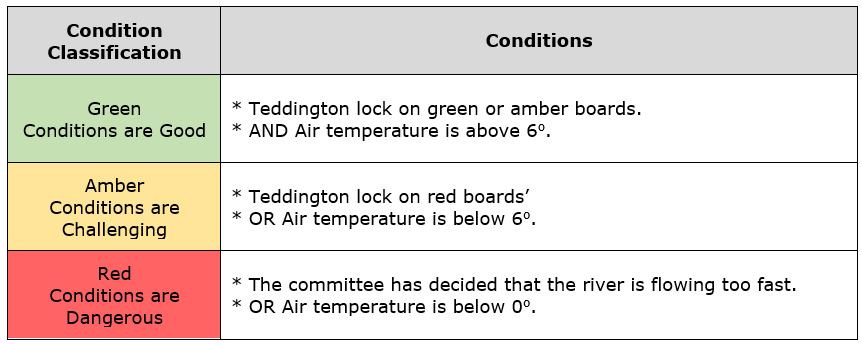Appendix 1
Additional Notes For Coaches And Committee
A1. Conditions
The ‘Red Amber Green Conditions’ (RAG) identified in the Actions table in the ‘Richmond Canoe Safety’ document will be specified by the committee on a daily basis. The table below can be used as a guideline but should not be treated as absolute.
Notes On Conditions
* When defining the RAG for the day the principal consideration should be:
- What impact will the conditions have on a paddlers ability to get themselves back in their boat following a capsize.
- What will increase the possibility of a paddler capsizing is not relevant as capsizing is part of the sport.
A2. Notes For Coaches
It is your responsibility to keep people in your group safe. The people in your group expect you to keep them safe. Everyone who does not know the first thing about canoeing expects you to keep them safe.
Some simple rules will help you
- If you believe that you and your assistant coaches cannot keep the whole group safe, cancel the session. Your word is absolute. Don’t succumb to pressure from the group or your peers. Your word is final. If you cancel any session for any reason the committee will back you.
- The RAG illustration specifies that under certain conditions a group must be led by a coach.
This does not mean that you have to take them out on the river.
As a coach will have the necessary experience to decide if all the individuals in a group have the necessary skills to cope with the conditions and if not you can cancel the session.
- Safety Briefing. All coached sessions for paddlers below Division 6 should start with a land-based safety briefing regarding the hazards present during the session.
- Things to consider when taking a group out.
Coaches
- Your own ability.
- Assistant coaches.
Before you start, assess the ability of your assistant coaches, some may be good enough to be coaches in their own right, while others may have just started as an assistant coach. Factor this in when deciding what you should do with the group.
The paddler
- If paddler and boat get separated, stay with the paddler, the club can always buy a new boat.
- Buoyancy aids.
Are the group wearing buoyancy aids that are the correct size and are they fitted correctly.
- The ability of each paddler.
If a paddler in you group has just moved into a less stable boat and conditions are challenging you may consider putting them back in a more stable boat until conditions improve.
- The speed of a paddler.
A faster paddler may be able to make progress against the flow where a slower paddler may not.
Conditions
- Wind on its own could increase the number of swimmers but it may not impact on your ability to get them back into their boats. However, when combined with an incoming tide it will cause problems. Likewise, when combined with low temperatures windchill will cause problems.
- Know when the tide is due to turn and to a lesser extent, the height of the tide.
See: https://www.tidetimes.org.uk/richmond-lock-tide-times
- River flow. Know how much water is flowing through Kingston (Fluvial) i.e. the flow regardless of what the tide is doing.
See – https://richmondcanoeclub.com/members/flow/kingston/
- Is any part of the session going to be in the dark (i.e. between sunset and sun rise). Remember lights are mandatory and perhaps you may need more assistants than you would normally have during daylight hours.
- Use of club equipment outside of club sessions.
If you wish to run a session outside of designated club sessions (i.e. those advertised on the club training schedule), you must first ask for permission from …. [Lead Coach or Water Safety Officer] so that this session becomes a designated Richmond Canoe Club activity and is therefore covered by our insurance.
A3. Extra Notes For Coaching Juniors.
- Juniors are not allowed to paddle without being supervised by an approved senior member of the club, typically a qualified coach.
- All Juniors must wear buoyancy aids.
A coach may give a junior permission not to wear a buoyancy aid in some conditions providing that the coach has consent from a parent or guardian to do so.
- Juniors are not allowed to paddle in the dark.

